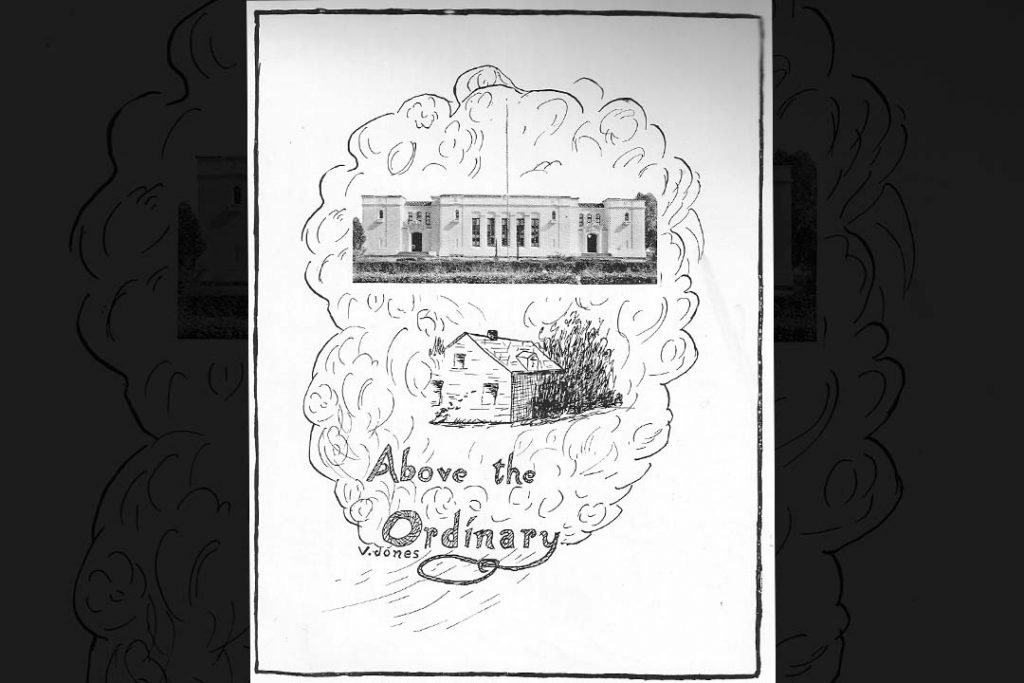
The first page of the 1921 Argus displayed the new 1920 administration building that is now preserved and occupied by the San Joaquin College of Law. The Argus was dedicated to John M. Cox: “Gentleman, scholar and apostle of efficient living.” His only son, Cecil Cox, was Clovis’ first Gold Star Hero of WWI.
In 1917, this graduating class boasted 50 students who entered as freshmen. Clayton Pendergrass was their President. It was shared that, “As this was the time when everyone was making four-minute Liberty Loan speeches, the Freshman [sic] took great interest and seven members made excellent speeches.”
Edith Stickles was chosen editor-in-chief of the Argus. We quote: “The question of raising funds for this task was also a great one. Pie and candy sales, fifteen-cent assemblies and an entertainment by Mr. Ben Scoville are some of the things which were carried on to-raise money.” G.M. Williams & Son of Fresno published the Argus. The pages were printed on high gloss stationery and the cover a sturdy brown paper with “The Argus” printed in gold.
Mr. H. Rode was Principal, and his nine-member faculty taught: chemistry, manual training, drawing, typing, bookkeeping, penmanship, physics, geometry, algebra, general science, United States, Mediaeval and Modern history, Latin, Spanish, French, musical history, English II, III, IV, Ancient History and domestic science.
The 22 graduating seniors shared their age, address and notoriety. Examples: “Clayton Pendergrass, overgrown boy, State Bank and tennis; Newman Bridges, ancient, moved and Senior President; Verdene Waite, giggling age, in an Oldsmobile, curls on Senior day; Claude Kirkpatrick, can go out alone, with brother Carl and woman hater and Mihran Qunjian bashful age, on his bicycle and his white panama hat.”
The class motto: “Safe on First, Now Score!”. The Board of Trustees: John H. Cadwallader, J. Webster Potter, James A. Riggs, Leslie D. Reyburn and H.W. Stanford.
Their freshmen initiation was described: “A program was not needed as our babies furnished entertainment enough. We shall never tell the awful things we did to them, but, girls, we hated to spoil those marvel waves. The party broke up early, as late hours are taboo with infants.”
Their class song (tune of “Down the Trail to Home, Sweet Home”): Second verse, “How well we remember the days at our games when winners and losers were loved just the same. Our teachers and studies were always close by –– these days will linger with our dear old High.”
The following student stories were published in the literary section: “The Leap for Freedom”
By T.F.,’22; “The Forrest Fire” by M.M., ’24 and “Getting Even With Mr. Martin” by V.J.,’21. The latter is about two brothers rescuing their sister from an unwanted suitor.
The Editorial section by editor Edith Stickles posed two questions to the High School Board that were of importance to the school: “(1) Shall there be another High School Bus –– or several others? (2) Shall the School District own its own cars?” She described the inequity of town pupils and country bus pupils who could not participate in extracurricular activities. That it would be productive for the buses (after nine in the morning until 1:00 or 2:00 p.m.) pick up kindergarten children for early training and that they would also benefit by “being under the eye of the district nurse.”
She recommended that the drivers of the district cars would tend the school grounds; i.e. furnace man, gardener, custodian and repair of athletic equipment and grounds during their “down” time.
The student body recognized the benefit of creating an agenda for debating, parliamentary law, dramatics and declarations. “The Athenaeum” (ancient Roman school) that promoted debates, current events, dramatic readings, recitations and music was created.
The tennis, track, baseball and basketball teams played against teams from Kerman, Sanger and Tranquility. Girl’s athletics: “During this season the girls did not enter into any league games except tennis. The tournaments were played by both girls and boys. The team won all the spring tournaments but lost the County Championship to Madera.”
A few jokes between faculty and students: “Mable Barton: Was William of Orange assassinated? Miss Tuft: Yes, he was shot through his window. Curley: Miss Tuft, I don’t think I should get a five on this Ex. Miss Tift: well, I don’t either, but I couldn’t give any lower. Mr. Gladfelter: Did you ever hear the “Heavenly Arcana”? Ted Forbes: Can’t say that I did. What show was she with? Miss Gove: Let’s keep a little still. Arthur Nevins: We can’t; it’s against the law.”
We share a few business advertisements: “For the very best tables and the latest up-to-date lighting system come to the Clovis Pool Hall, corner of Fulton and Fifth to spend your leisure hours, good service, G.W. Hutchison & Son, Props. Phone 55-W. First State Bank, Clovis, California, capital $25,000, surplus $35.000. The Bank of personal service. C.M. Beasley, Willys-Overland Automobiles, general repair shop, Samson Tractors, trucks, zenith carburetors. Philadelphia batteries.”
The 1921 Clovis High students are a part of our rich heritage.








